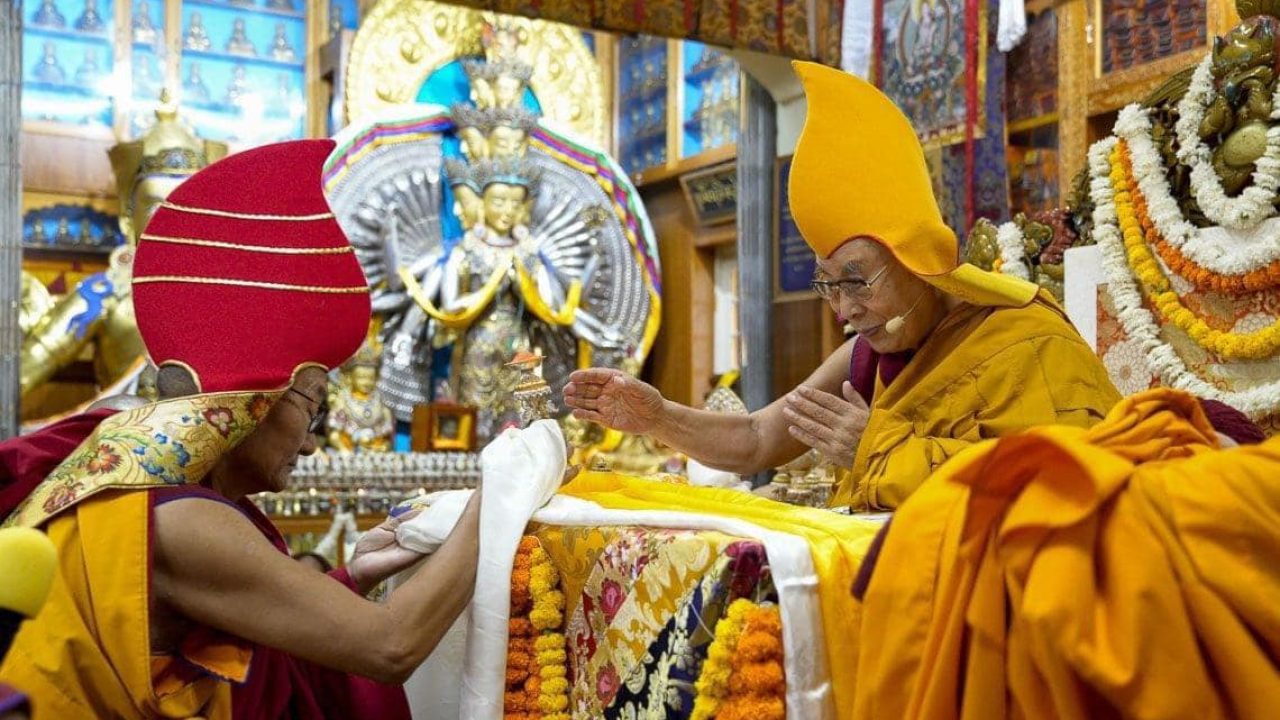“As long as space endures,
And as long as sentient beings remain,
Until then, may I too remain
To help dispel the misery of the world”
I renew the wish expressed in this verse every day.
H.H. The Dalai Lama
Thekchen Chöling- This morning five organizations, the Tendhong Cultural Preservation Society (Mön), All Jonangpas, the Domey-Mang-Bha-Ja-Sum Association, the Namgyal Higher Secondary School, Nepal, and the Sydney Tibetan Association came together to offer a prayer for His Holiness the Dalai Lama’s long life at the Tsuglagkhang, the Main Tibetan Temple in Dharamsala. His Holiness met their representatives at the gate to his residence and they escorted him as he walked through the temple yard, smiling and waving at well-wishers on the way. He was presented with the traditional Chema Changpu from which he took a pinch. Further on a group of dancers performed for his delight.
There were more than 250 Jonangpas have been participated in that Long Life Prayer, 160 Jongnangpas from Miao, that place is located in north-east India. The Noa-dihing is the most important river flowing through Miao. The mountain range is called Patkai Bum and is the eastern extension of the Himalayas, About 30 Jonangpas from Shimla including Kyabjee Rinpoche and former Khanpo, about 15 Jonangpas from Nepal including Geshe Lharampa Trimey Owser, 5 Jonangpas from Bhutan and Jonangpas from other parts of India.
Ganden Tri Rinpoché came forward to welcome His Holiness as proceedings began with the recitation of a tribute to the various incarnations of Avalokiteshvara who have appeared in India and Tibet.
Jonang Gyaltsab Rinpoché was in the middle of offering emblems of the eight auspicious substances when the Nechung Oracle appeared in spontaneous trance and came forward to pay his respects to His Holiness.
Representatives of the patrons of today’s ceremony filed past the throne and received a silk scarf and protection cord from His Holiness. Guru Tulku Rinpoché offered a silver statue of Thangtong Gyalpo.
In the temple, facing His Holiness as he sat on the throne before the statue of Buddha Shakyamuni was a line of lamas who led the prayer—Gyabong Rinpoché, Abbot of Tawang Monastery, the Dorjé Löbpön of Namgyal Monastery, Jonang Gyaltsab Rinpoché, Ganden Tri Rinpoché, Ling Rinpoché, Guru Tulku Rinpoché and Khenpo Nyima Tashi, Abbot of the Kagyu Monastery in Jang, Tawang, Arunachal Pradesh.
“In this life alone I’ve been able to serve the Dharma and sentient beings and I make a determination to live long in order that I may continue to do so. I feel I can live for another 10 to 20 years or so. I’m not concerned with money or fame, only with being able to benefit others. And for that reason, I pray to live long. The prayer that is being performed today involves Arya Tara and I say her mantra for longevity every day.
“During my recent visit to Ladakh and Zanskar I was moved by the faith and trust of the people there. Tibetans in Tibet are also unflinching in their devotion, but they are living under oppressive conditions. Meanwhile, an increasing number of people in China are taking an interest in Buddhism and even Chinese officials are beginning to acknowledge that I’m not the reactionary they make me out to be. In fact, in Tibet, it’s not just a matter of human beings, there are spirits and deities who have faith in me because I’m resolute in my efforts to cultivate the awakening mind of bodhichitta for the benefit of others.”
“As I said earlier,” His Holiness remarked, “I have strong links with the people of Arunachal Pradesh and the Himalayan region. Because of karma and past prayers, I have been able to serve them as well the Dharma and other sentient beings. And because I have this opportunity, I firmly aspire to live another two decades. I’d like to thank all of you, members of these five different organizations, for conducting this ritual for my long life today.
“I understand the Covid pandemic is rife in Arunachal Pradesh and also in Tibet. I will make prayers that it may be subdued. In China too the situation is serious. Let’s pray to Arya Tara to help Tibetans and Chinese at this time, to relieve their suffering and alleviate the fear in their minds. We also need to remember the people of Xinjiang with love and compassion.
Finally, His Holiness was requested to give the oral transmission of the six-syllable mantra, Om mani padme hung, which he did. He revealed that he recites this mantra, along with the ‘Praise to the Buddha for Teaching Dependent Arising’, every morning and prays to Avalokiteshvara that there may be peace in the world. He led the crowd in reciting a full rosary of Om mani padme hung.
